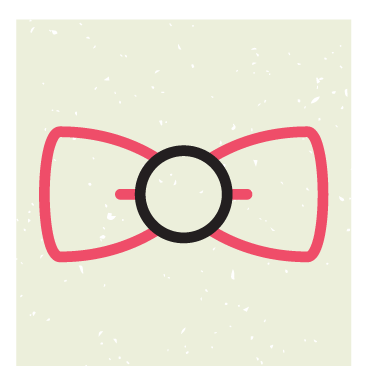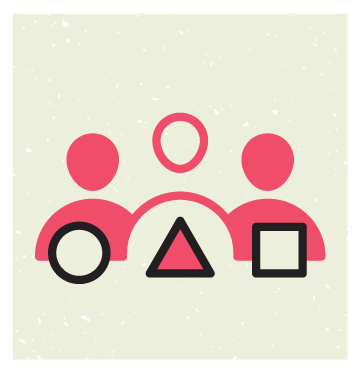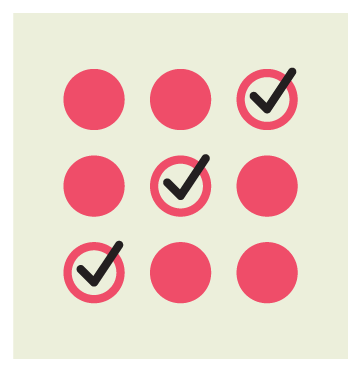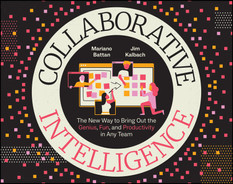
Chapter 3
Collaboration Design
Making The Collaboration Experience Deliberate
“Have an agenda.”
That's the secret to holding better meetings, right?
But think about the last meeting you were in with an agenda. Did it go well? We mean really well—no egos and no politics getting in the way of achieving the team's goals. It probably didn't.
Having an agenda is good table stakes, but it won't fix a badly organized, poorly run meeting.
There's much more to consider. Are the right people invited? Are they able to participate meaningfully, to contribute? How will you lead so that people feel engaged—connected and wanting to be part of the work being done? How will everyone know progress was made? And how well will the collaboration of the team work over time?
The list goes on, but these kinds of issues have to be worked out again and again when leaders leave collaboration to chance. There's no thoughtfulness, no consideration, no design to how the collaboration should unfold.
Someone has to raise their hand to guide the team. It doesn't have to be a lot of work. Sometimes a simple nudge is all it takes: Just leading a warm‐up, ensuring fair turn‐taking, and providing solid follow‐up can change the dynamics of an entire team and drive better results. It's about paying attention to collaboration as the collaboration happens, either in real time or when working apart. Because here's the thing: Collaboration happens whether it's deliberately guided or not.
Who Can Fix Bad Meetings? (Hint: Anyone)
As workplaces become less hierarchical and more reliant on team imagination, the ability to design productive collaboration is quickly becoming a skill everyone on any knowledge‐work team needs to have. Equipping everyone in an organization with the ability to improve team interactions will simply lead to more innovation faster.
Collaboration designers don't have to be subject matter experts or professional facilitators. At its fundamental level, collaboration design is about helping people go forward. And anyone can do that. From this perspective, you may very well already be a collaboration designer and not know it.
What exactly is collaboration design? It's a new discipline that seeks to democratize methods and better ways of working into learnable skills that anyone can acquire. It's about working with the team, meeting them where they are, and helping them accomplish their goals.
Facilitation and collaboration design are particularly close cousins, but they differ in some very important ways.

Collaboration design can be formal or informal. Collaboration design is both a general skill set and a formalized role. We envision professionals specialized and certified in collaboration design, but anyone leading teams and conversations can learn and develop collaboration design skills—from individual contributors to managers and beyond.
Collaboration design will be an embedded function. Every team benefits from collaboration design know‐how, which is why we see this new field materializing as a foundational skill that will be widespread across organizations in the future. As a result, champions will emerge to guide teams from their own ranks.
Collaboration design leverages asynchronous communication. Typically, facilitation happens in live meetings in real time, though it might occasionally include some preparatory or follow‐up tasks. Collaboration design goes beyond these limitations to include asynchronous collaboration habits and behaviors of the team as well as synchronous meetings.
Collaboration design considers team development and evolution over a longer term. Solving for disconnection in teams doesn't happen overnight or even in a few sessions. Collaboration design is all about building the relationships between team members over time and considering the health of the team in the long run.
At its core, collaboration design requires attention and empathy. Pulling from Agile practices, design thinking, and facilitation as well as the fields of organizational design, psychology, and employee experience, collaboration designers stack the deck in favor of “aha moments” by catalyzing conversations, relationships, and intelligent collaboration.

What Does a Collaboration Designer Do?
Consider Blake: He came up through the ranks of client‐facing teams at the global consultancy where he works. Blake ran a lot of workshops with clients and also worked closely with internal teams to plan accounts. But he noticed things were disjointed, particularly the client experience.
Like everybody else, Blake's work relied on meetings. And when the meetings didn't go well, work didn't go well. “People were trying to run meetings like they would offline, but online,” he told us. “And scheduling a meeting happened way too easily here—people gathered at the drop of a hat whether it was needed or not.”
Blake was already interested in topics around the future of work and facilitation in general, and he got certified in design thinking methods with LUMA. He also saw that as greater flexibility in work location became the norm, no team could assume everyone would be present in an office for a given meeting or workshop, and they'd have to be able to survive with a mix of participants at all times—some in‐person and some remote. As he puts it, “Hybrid requires different etiquette within the group. There has to be an implicit awareness of each others’ ability to participate, and getting the right habits is key.”
It wasn't long before Blake was recognized as someone who could make teams work better together. Leaders found real value in the example he set. After the company re‐orged into new pillars, they created new cross‐functional roles, including dedicated collaboration designers. Now Blake and his small team improve collaboration frontstage as facilitators as well as doing backstage work with a type of “collaboration ops.” They select common methods for teams to use and roll them out. They develop and advocate shared rituals. They've put together training videos promoting good collaboration hygiene and a library of meeting and workshop templates. They use surveys and polls to get feedback on how people are working together, which helps them improve and plan better collaboration.
Blake's role is now strategic. The new company org wouldn't function without the type of cross‐functional connections he's built. He's taken what was originally an academic interest in new ways of working and literally made a career out of it.
How Can You Make Collaboration Work Better?
Blake is one of the first of his kind as a dedicated collaboration designer, but anyone running meetings can and should learn from the cutting‐edge practices he and others like him are using to make team collaboration more intentional and productive.

Create a common collaboration space. First, you need to be deliberate about creating a common space for collaboration. This is about making sure everyone has a shared context and a shared medium of exchange. A collaboration designer doesn't even take for granted that people in the same room will be present to each other in the same collaboration space.
Make the space safe. The most important job of a collaboration designer is to create psychological safety for the team. Trust is foundational for collaboration to take hold, and the collaboration designer should initiate and host an explicit conversation about creative safety with the team.
Put diversity and inclusion into practice. Including and welcoming others is core to collaboration. Collaboration designers proactively seek contributions from the team by considering different work styles and preferences in the design of the collaboration because diversity must be baked in from the start.
Align on purpose. To focus a team's energy, there has to be a clear purpose. A collaboration designer orients collaboration to the team's mission. This is not just a clear agenda, which only gets at the what of collaboration. A well‐defined purpose also speaks to the why. But it need not be delivered in a lengthy challenge statement. Collaboration designers are skilled at simply and directly sharing the intent behind the collaboration with the team before collaboration begins.
Build ongoing connections. Despite a hundred ways to communicate, people still feel disconnected from each other, from their teams, across departments, and with the larger enterprise and its goals. Collaboration design must include creating time and space for people to connect, particularly when chance meetings in a physical office are less and less common.
Guide problem‐solving. Teams at work are expected to deliver business outcomes. Collaboration designers are proficient in selecting and implementing guided methods, or repeatable, structured approaches to direct collaboration, which help their teams solve problems and innovate together. Like exercising or building muscle, a team's ability to solve problems together gets better the more they work together and practice methodical approaches to how they collaborate.
Roll out best practices. Collaboration designers identify methods that deliver the best results and create healthy teams. They gather and modify these best practices into templates and playbooks before rolling them out more broadly. Good curation skills are needed, too, for evaluating and updating methods of collaboration in the long term.
Assess collaboration quality. Collaboration designers reflect on and assess collaboration over time—at the individual, team, and organizational levels. Insights can come from a range of sources and can be informed by both quantitative metrics and qualitative feedback. Guidance from these insights about collaboration takes the guesswork out of teamwork.
Ensure growth and development. In healthy teams, members should have the opportunity to learn and grow over time. Collaboration designers help each collaborator become more skilled at working together. Of particular importance is helping teams become more proficient in different modes of work, from in‐person to remote to hybrid, as well as synchronous and asynchronous collaboration.
Make time to reflect. Regular reflection and introspection as a group helps the team continuously improve how they work together. To create a culture of collaboration, teams have to be able to talk about how they are collaborating.
Declaration of Interdependence
The healthiest, most effective teams we've observed make how they intend to work together explicit. Team charters or social agreements document how a team intends to interact.
A team charter is an agreement about how your particular group of teammates will best work together. These documents outline the essential elements of your team's communication and define a set of concepts and skills that will focus and guide you.
A typical charter documents several elements of a collaboration, including those shown in the following figure:

Team Charter
The best way to set up your team for success is to create a team charter: a set of concepts and skills that focus your team.

A focus on working arrangements and norms helps avoid confusion and miscommunication. We've seen detailed agreements that list tools the team will use, how to schedule meetings across time zones, what the expected turnaround times on answering questions from others should be, and more.
Sarah B. Nelson, chief design officer at Kyndryl, has coached teams and created team agreements for years. She told us:
Understanding the Collaboration Experience
We've described the role of the collaboration designer as meeting teams where they are and helping them accomplish their goals and connect as individuals. But how can we find where our teams are? That is, how can we trace the experience of collaborating teams over time?
You've likely seen plenty of models that show ideas and innovations moving through cycles. Having worked closely with hundreds of teams across virtually every industry over the past decade, we've learned that teams cycle through phases too.
In fact, if we model the collaboration experience of a team over time, it looks like a journey through two distinct cycles: affective collaboration (how group members feel toward each other while interacting) and effective collaboration (how well they accomplish productive tasks). Each has its own phases that collide or coincide with the other as collaboration unfolds.
This is why the CEO of change agency Voltage Control, and one of our close partners, Douglas Ferguson, underscores that:

The discipline of collaboration design seeks to support and utilize these cycles. Balancing the two core elements of collaboration, skillful designers support a team throughout the quest to make something new.
Viewed from start to finish, collaborative intelligence is a journey filled with guided methods that are empathic and analytical, artistic and intellectual, playful and rigorous. Although there are many factors to consider—such as tools and technology for collaboration—at the core of the collaboration experience are these two jobs: connecting and problem‐solving. Let's look at each in more detail.
Connecting
We know that in order to connect, teams need relational intelligence—the ability to develop interpersonal relationships among a group of people striving toward a common purpose. That connection is a mindset shift toward teams and teamwork that unfolds in four phases.


Trust. The members of a high‐performing team must learn that others can respect individual contributions and will have their best interests in mind. In this stage, we cue collaboration activities that invite appropriate levels of vulnerability and encourage people to tune into each other. Through simple activities designed for connection, people on teams begin to build mutual understanding, appreciating that perfection is not required but mutual commitment to common ends is.
Commit. With trust established, people can commit to the common pursuit of a goal. In the commitment stage, the team—implicitly or explicitly—agrees to lean into a shared pursuit of addressing and solving a challenge.
Learn. A group grows together through experimentation, developing solutions, and investigating ways their work can gain momentum. At this stage, a team is focused on an objective, and it should be free to test, prototype, keep, and discard any ideas that have been brought to the table. This stage is notably generative. When teams are in this mode, their collective imaginations are unleashed and something new becomes possible.
Accomplish. At this stage, the group has explored its best thinking and is converging on what, when, and how to execute. Group members take collective ownership of their output and greater appreciation of the diverse skill sets that made their new idea come to light. And because they've directly experienced group actualization, they're willing to imagine together again.
Of course, we recognize other models of team formation and connection that have influenced our thinking. An especially notable one is Bruce Tuckman's 1965 concept of these phases in team evolution1:

- Forming. In this phase, the group not only comes together to form, it also develops relationship skills needed to work together.
- Storming. Next, group members focus their attention and energy on the challenge at hand and begin to explore ways to solve it. Conflict and resistance may emerge as the team seeks to find common ground.
- Norming. Group members eventually create harmony and strive to find effective ways of collaborating.
- Performing. Actual task execution and problem‐solving happens in this phase. Personal needs are put aside in favor of the success of the whole team.
- Adjourning. A fifth phase was added to the model by Tuckman in 1977 to reflect completion of the challenge at hand. Celebrating accomplishment is key at this point in order to encourage and motivate members.
Solving Problems
There are four arcs in our process: imagining, aligning, validating, and activating. These phases are found in similar form in any tried‐and‐true problem‐solving process, and they also occur naturally in living systems, which diverge, explore, converge, exploit, and then start all over again.


Imagine. Imagining is about teams coming together in collaborative spaces to freely externalize and visualize ideas, expanding and building on each other's thinking. In this phase, the focusing question of the team is “What might we do?”
Align. Aligning involves the application of specialized methods and facilitators to help the team synthesize, prioritize, and consider making decisions. The clarifying question here is “How does it feel?” This inquiry helps teams discern if they're headed in the right general direction.
Validate. Validating is about teams being able to model, build, and execute experiments, identifying the candidates for solutions with the most promising potential. The unifying question in this phase is “How is it going?” This deceptively simple question is a reality‐ and a gut‐check for the team in process.
Activate. Activating is where the rubber hits the road. This phase is when ideas are operationalized through planning, execution, and pipelining into core business systems and workflows. The pointed question here is “What are we making?” In this phase, the team is in builder mode. The energy and attention is on the manifestation of the ideas and solutions they've produced together over the cycle.
The framework of this problem‐solving process is linear, but we purposely make room for activities to shift around. This is where the craft of collaboration design shines. Collaboration design know‐how makes it possible to adjust dynamically while nurturing a healthy exchange within the group.
Less of a prescription or a rigid path, our model of the collaborative experience weaves the most potent forces of collaboration design—connecting with each other through relational intelligence and solving challenges together—to reflect the nonlinear reality of deep group work while also elevating it.
Modeling Collaboration Experiences
Collaboration design isn't just about improving meetings that happen in real time. It's also about the behaviors and activities that happen in between live interactions. And it's about the development of teamwork, belonging, and accomplishment over time, as well. Our model of collaboration integrates all of these elements.
At the simplest level, you can think of any collaboration experiences as having a beginning, middle, and end.
The core of this model is problem‐solving.
This kind of problem‐solving is perhaps the most intensely collective point in the model: It's where the team must truly collaborate at the same time. Still, at its opening, problem‐solving is characterized by divergence, as the team engages in explorations, spreading out in search of a solution. This is followed by the group converging as a team to make decisions. Over time, this process is shaped like an emerald (Figure A on page 51), with work opening out (as our friends Dave Gray, Sunni Brown, and James Macanuf034 put it in Gamestorming) from a starting point and then coming together to close in on a solution.
At the same time, collaboration design recognizes that any team problem‐solving must be connected to development of the team and the relationships within the group. Being deliberate about the relational layer here means taking time to connect before problem‐soving and reflect together afterward (Figure B at right).
But it's not only the synchronous collaboration behaviors that matter. While spending time together, whether in‐person or remote, is important, the real power in collaboration design lies in managing individual asynchronous work. This happens both before and after real‐time interactions (Figure C at right). Zooming out, the model starts to become more complete.

Zooming out even further, we can look at how the collaborative behaviors of the group improve over time. This includes assessing how the group is performing by using both quantitative and qualitative insights.
At this level, we see that the overall design of collaboration is nested and iterative. Teamwork is situated in the context of other projects and ongoing work. One interaction might be part of a continuum of arcs within larger loops of work. Collaboration design is ultimately about understanding the intent of the collaboration and placing it in a broader scope, and creating experiences that both connect team members and drive business outcomes.
Here's the best part about the fact that this model is not linear: It means you can start anywhere at any time. Over time, relationships build and teams improve their ability to problem‐solve.
In other words, the best time to start being more intentional about collaboration is right now. Take the next meeting you have coming up. Introduce a new practice, such as a brief check‐in or warm‐up. See how it goes, and iterate from there. Then start introducing more and more collaboration methods. You'll soon see that there's no shortage of these practices—and ways to combine them.

Note
- 1 Bruce Tuckman, “Developmental sequence in small groups,” Psychological Bulletin (1965)
